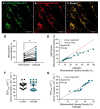Cell-Based Measurement of Mitochondrial Function in Human Airway Smooth Muscle Cells
- PMID: 37511264
- PMCID: PMC10380259
- DOI: 10.3390/ijms241411506
Cell-Based Measurement of Mitochondrial Function in Human Airway Smooth Muscle Cells
Abstract
Cellular mitochondrial function can be assessed using high-resolution respirometry that measures the O2 consumption rate (OCR) across a number of cells. However, a direct measurement of cellular mitochondrial function provides valuable information and physiological insight. In the present study, we used a quantitative histochemical technique to measure the activity of succinate dehydrogenase (SDH), a key enzyme located in the inner mitochondrial membrane, which participates in both the tricarboxylic acid (TCA) cycle and electron transport chain (ETC) as Complex II. In this study, we determine the maximum velocity of the SDH reaction (SDHmax) in individual human airway smooth muscle (hASM) cells. To measure SDHmax, hASM cells were exposed to a solution containing 80 mM succinate and 1.5 mM nitroblue tetrazolium (NBT, reaction indicator). As the reaction proceeded, the change in optical density (OD) due to the reduction of NBT to its diformazan (peak absorbance wavelength of 570 nm) was measured using a confocal microscope with the pathlength for light absorbance tightly controlled. SDHmax was determined during the linear period of the SDH reaction and expressed as mmol fumarate/liter of cell/min. We determine that this technique is rigorous and reproducible, and reliable for the measurement of mitochondrial function in individual cells.
Keywords: airway smooth muscle; confocal microscope; mitochondria; oxygen consumption; succinate dehydrogenase.
Conflict of interest statement
The authors declare that the research was conducted in the absence of any commercial or financial relationships that could be construed as a potential conflict of interest.
Figures










Similar articles
-
Heterogeneous distribution of mitochondria and succinate dehydrogenase activity in human airway smooth muscle cells.FASEB Bioadv. 2024 May 28;6(6):159-176. doi: 10.1096/fba.2024-00047. eCollection 2024 Jun. FASEB Bioadv. 2024. PMID: 38846375 Free PMC article.
-
TNFα-mediated subcellular heterogeneity of succinate dehydrogenase activity in human airway smooth muscle cells.Am J Physiol Lung Cell Mol Physiol. 2025 Jun 1;328(6):L792-L808. doi: 10.1152/ajplung.00396.2024. Epub 2025 Apr 23. Am J Physiol Lung Cell Mol Physiol. 2025. PMID: 40266735 Free PMC article.
-
Visualization of mitochondrial respiratory function using cytochrome c oxidase/succinate dehydrogenase (COX/SDH) double-labeling histochemistry.J Vis Exp. 2011 Nov 23;(57):e3266. doi: 10.3791/3266. J Vis Exp. 2011. PMID: 22143245 Free PMC article.
-
Assembly of mitochondrial succinate dehydrogenase in human health and disease.Free Radic Biol Med. 2023 Oct;207:247-259. doi: 10.1016/j.freeradbiomed.2023.07.023. Epub 2023 Jul 23. Free Radic Biol Med. 2023. PMID: 37490987 Review.
-
Isocitrate dehydrogenase (IDH), succinate dehydrogenase (SDH), fumarate hydratase (FH): three players for one phenotype in cancer?Biochem Soc Trans. 2016 Aug 15;44(4):1111-6. doi: 10.1042/BST20160099. Biochem Soc Trans. 2016. PMID: 27528759 Review.
Cited by
-
Similar deficiencies, different outcomes: succinate dehydrogenase loss in adrenal medulla vs. fibroblast cell culture models of paraganglioma.Cancer Metab. 2024 Dec 23;12(1):39. doi: 10.1186/s40170-024-00369-9. Cancer Metab. 2024. PMID: 39716277 Free PMC article.
-
Heterogeneous distribution of mitochondria and succinate dehydrogenase activity in human airway smooth muscle cells.FASEB Bioadv. 2024 May 28;6(6):159-176. doi: 10.1096/fba.2024-00047. eCollection 2024 Jun. FASEB Bioadv. 2024. PMID: 38846375 Free PMC article.
-
TNFα-mediated subcellular heterogeneity of succinate dehydrogenase activity in human airway smooth muscle cells.Am J Physiol Lung Cell Mol Physiol. 2025 Jun 1;328(6):L792-L808. doi: 10.1152/ajplung.00396.2024. Epub 2025 Apr 23. Am J Physiol Lung Cell Mol Physiol. 2025. PMID: 40266735 Free PMC article.
References
MeSH terms
Grants and funding
LinkOut - more resources
Full Text Sources
Research Materials

